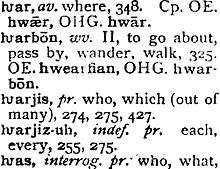Hwair
Hwair (also ƕair, huuair, hvair) is the name of 𐍈, the Gothic letter expressing the [hʷ] or [ʍ] sound (reflected in English by the inverted wh-spelling for [ʍ]). Hwair is also the name of the Latin ligature ƕ (capital Ƕ) used to transcribe Gothic.


Name
The name of the Gothic letter is recorded by Alcuin in Codex Vindobonensis 795 as uuaer. The meaning of the name ƕair was probably "cauldron, pot"[1] (cf. ƕairnei "skull");[2] comparative reconstruction shows *kʷer- (“a kind of dish or pot”) in Proto-Indo-European.
There was no Elder Futhark rune for the phoneme, so that unlike those of most Gothic letters, the name does not continue the name of a rune (but see qairþra).
Sound
Gothic ƕ is the reflex of Common Germanic *xʷ, which in turn continues the Indo-European labiovelar *kʷ after it underwent Grimm's law. The same phoneme in Old English and Old High German is spelled hw.
Transliteration
The Gothic letter is transliterated with the Latin ligature of the same name, ƕ, which was introduced by philologists around 1900 to replace the digraph hv, which was formerly used to express the phoneme, e.g. by Migne (vol. 18) in the 1860s. It is used for example in Dania transcription.
Related letters and other similar characters
- ʘ : IPA letter Bilabial click
- Ԋ ԋ : Komi Nje, a letter in the Molodtsov alphabet
- Ꙩ ꙩ : Cyrillic letter Monocular O
- ん : N (kana)
- Խ խ : Armenian Khe
Computing codes
| character | 𐍈 | Ƕ | ƕ | |||
| Unicode name | Gothic letter Hwair | Latin capital letter Hwair | Latin small letter HV | |||
| character encoding | decimal | hexadecimal | decimal | hexadecimal | decimal | hexadecimal |
| Unicode | 66376 | 10348 | 502 | 01F6 | 405 | 0195 |
| UTF-8 | 240 144 141 136 | F0 90 8D 88 | 199 182 | C7 B6 | 198 149 | C6 95 |
| Numeric character reference | 𐍈 | 𐍈 | Ƕ | Ƕ | ƕ | ƕ |
Note that the Unicode names of the Latin letters are different: "Hwair" and "Hv".[3]
See also
- Phonological history of wh
- Wh (digraph)
References
- cognate with Sanskrit caru "pot"); see e.g. Karl Ljungstedt, Anmärkningar till det starka preteritum i germanska språk (1887), p. 165. Hans Jensen, 00Die Schrift in Vergangenheit und Gegenwart, 1935, p. 38 Kratylos vol. 1-2, 1956, p. 175.
- Mark 15:22 ƕairneins staþs = κρανιου τοπος "Golgatha".
- "Latin Extended-B: Range: 0180–024F" (PDF). The Unicode Standard, Version 6.0. Unicode Inc. 2010. pp. 21, 18. Retrieved 2011-10-15.